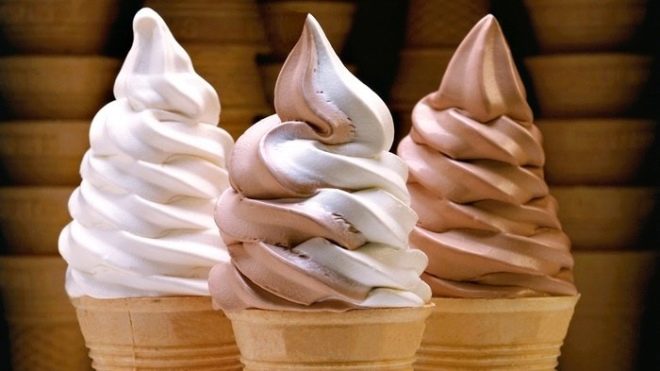At what age can you give your child ice cream and how best to cook it at home?
What could be better than a portion of ice cream on a hot summer day! It refreshes, pleases with its pleasant taste, gives physical and emotional pleasure. No wonder everyone loves him. Quite often the question arises, is it possible to give a treat to children and from what age this product is allowed. We will tell about it in this article.
Benefit and harm
Ice cream is a product of milk processing, and therefore there is essentially nothing harmful in it. There are calcium, amino acids, milk protein, vitamins. But this is only at first glance. Good ice cream, which is made from milk, cream, butter, may indeed be useful, but there are a few “buts”.
Natural ice cream in retail sales today is almost impossible to find. Even expensive varieties, the producers of which position their goods as “exclusively natural”, are cunning: without preservatives, their products could not be stored for a long time even in a freezer.
98% of ice cream types have palm oil, other vegetable fats that should not be in ice cream initially. Ice cream, therefore, is not only fatty, but also very sweet. Sugar and fat - a combination that is hard digested and absorbed in a child's body, and therefore the question of the age at which this delicacy can be given to a child is very reasonable.
Cow protein at an early age often causes allergies in children: their bodies simply cannot break it down. Cow's milk in large quantities is usually not recommended for children under 3 years. The issue of sugar consumption is also quite acute, because the pancreas of a child with great difficulty cope with the task of producing insulin to break down glucose. In addition, sugar is harmful not only for the appetite of the child, but also for the health of his teeth, the metabolism in general.
Understanding this, a reasonable age at which ice cream can be given to a child is 3 years.
Baby ice cream is completely unnecessary. There is nothing in it that would be necessary for the health of a young child, but it can harm the child.
In practice, most parents begin to give the child ice cream much earlier than the age of three. They may argue that nothing pathological happens to the child. Indeed, not all children have an allergy to cow protein, and the health of teeth one portion of cold delicacy is unlikely to have a negative impact. As is the case with many other foods, ice cream needs to be dealt with individually.
Dangerous treat can be for children. with diabetes, with diseases of the pancreas, obesity, with lactase deficiency. For such children, treats should be authorized by the attending physician. The rest of the children are given an ice-cream by their own will and decision. It remains only to hope that the decision was balanced.
Opinion of Dr. Komarovsky
The famous pediatrician Yevgeny Komarovsky argues that everything should be in moderation, including ice cream. If you treat a child with this delicacy no more than twice a week, there will be no harm.
According to the doctor, ice cream is not only a pleasant sweetness, but also a great benefit if it is eaten in small pieces with a small spoon. This is a tasty way to prevent diseases of the oropharynx, tonsillitis and tonsillitis. With a reasonable consumption of ice cream helps strengthen local immunity, strengthen the lymphoid tissue of the tonsils. This method of hardening of the throat is especially good for children who often suffer from respiratory diseases.
But you need to know the measure - one serving for a child should not exceed 100 grams of a delicious delicacy. Preference should be given to plain white ice cream, without additives, dyes, chocolate and canned fruit.
For information on how to harden the throat with ice cream, see the transfer of Dr. Komarovsky.
How to choose?
Purchased ice cream for a child should not be crystallized, heterogeneous. Nuts, icing, caramel and other "charms" should be left for adults. They will not bring any benefit to the child. Considering that it is almost impossible to find ice cream without preservatives from natural milk in stores, it is worth trying to make a dessert yourself at home.
Popular today the so-called "Soft" ice cream is contraindicated for children at any age and in any health condition. Milk is not in it at all.
It uses only vegetable fats and dyes, as well as flavor enhancers. A full-fledged natural ice cream simply could not be maintained in such a semi-decayed state, in which the mixture is in the apparatus with soft ice cream.
If you buy factory ice cream, pay attention to the integrity of the package. If it is broken, no one will give you guarantees that the child will not receive food poisoning either.
Homemade ice cream
If you are determined to treat your child with ice cream, but want the benefit of such a delicacy to be more than harm, let's learn how to make ice cream by yourself.
There are quite a few recipes for this dessert. But, since we are cooking for our little ones, we’ll focus on the classic white milk ice cream.
Ice cream, which implies the presence of butter and cream, is too fat, and dairy ice cream will be a great alternative for those children who are very reluctant to drink regular milk.
Low-fat homemade ice cream
For the preparation we need:
- two and a half cups of milk (about half a liter);
- a glass of sugar;
- 4 chicken eggs;
- a little vanillin, if the child is not allergic to it.
First you need to sift the sugar through a sieve, pour it into a non-metallic bowl and gently enter into it the yolks previously separated from the proteins. Stir all until smooth, to a mass of white.
Heat the milk, but do not boil, if there is a kitchen cooking thermometer, measure the temperature of the liquid - the milk should be about 80 degrees.
Transfer the sugar-egg mass to the enameled bowl and, gently stirring it with a wooden spoon or spatula, pour in a thin stream of hot milk. Put the saucepan on a slow fire and, like custard, stirring slowly, bring to a thickening. Boil is not necessary.
As soon as the mass becomes thicker, it must be removed from the heat, filtered through a sieve, put into shape, cooled to room temperature. After that you can put our homemade ice cream in the freezer. A few hours later the dessert is ready to eat.
If you want to treat your child to ice cream, there is nothing easier - in the milk mixture, which we have already done, before freezing, you can add chopped berries, apple slices, apricot - what the child likes.
Curd mousse
Ice cream is a great way to “fool” a child for the sake of his own good. So, you can feed the curd one who does not eat cottage cheese. To do this, cook blender cheese mousse (mix cottage cheese, some sugar, vanilla, some milk). When the mousse will be homogeneous, like cottage cheese cream, add a few berries in it and place in the form. After five minutes, the mass can be put in the freezer, and after another 4 hours the dessert will be ready.
Fruits can be added to curd ice cream.
To learn how to make ice cream from low-fat cottage cheese, see the transfer of Dr. Komarovsky.
Fruit ice
Of course, it's easier than simple to make homemade fruit ice. Use freshly squeezed homemade juices. They just need to freeze. An hour after placing the form with the juice in a cold place in each form of sticks, and add more juice on top. After a few hours, dessert can be offered to the child.
You can see a master class on making fruit ice from kiwi and strawberries in the next video.



































































